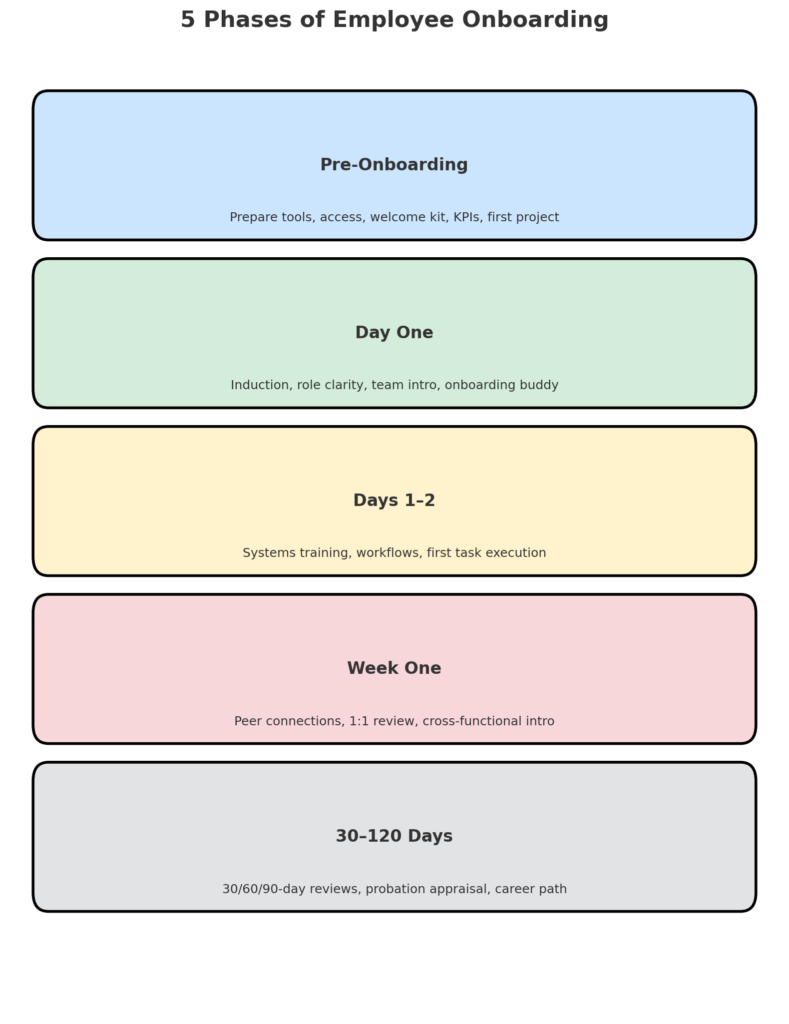Meta Title: The Ultimate Onboarding Guide (2025): Employee Engagement & Retention
Meta Description: Discover the complete onboarding guide for 2025. Learn step-by-step how to welcome employees, improve engagement, boost productivity, and reduce turnover.
Introduction: Why Employee Onboarding Matters
Employee onboarding is more than just orientation—it’s the strategic process of welcoming new hires, equipping them with the right tools, and aligning them with company goals. Done right, onboarding reduces turnover, accelerates productivity, and strengthens engagement.
According to research:
- Employees with structured onboarding are 69% more likely to stay for three years.
- New hires become 50% more productive in their first months with a clear onboarding roadmap.
This guide will help you design a step-by-step onboarding program that works for your organization.
The 5 Phases of a Successful Employee Onboarding Process
1. Pre-Onboarding: Prepare Before Day One
The employee experience starts before they arrive. Pre-onboarding ensures readiness and builds excitement.
Checklist:
- Prepare laptop, tools, and software access.
- Send welcome email and joining instructions.
- Share role description, KPIs, and first project plan.
🔑 Keyword Tip: Use terms like pre-onboarding process, employee readiness, and first day preparation.

2. Day One: Deliver Clarity & Connection
The first day sets the tone. Focus on making the new hire feel valued and confident.
Best Practices:
- Conduct an induction session (policies, culture, structure).
- Share role expectations and success metrics.
- Introduce team members and assign an onboarding buddy.
👉 Goal: Employee feels welcomed, clear about their role, and aligned with company culture.
3. Days 1–2: Tools & Training for Independence
Help employees become productive quickly by ensuring systems mastery and workflow clarity.
Action Steps:
- Provide training on communication and workflow tools.
- Share role-specific process guides.
- Assign a small but meaningful first task.
👉 Keyword Focus: employee training, tools orientation, workflow onboarding.
4. Week One: Build Belonging & Engagement
Social connection drives long-term retention.
Action Steps:
- Facilitate introductions to peers and cross-functional teams.
- Conduct a 1:1 progress check-in.
- Encourage informal bonding activities.
👉 Goal: Employee feels like part of the team within the first week.
5. Ongoing Support: 30/60/90-Day Reviews
Onboarding continues beyond the first week. Structured follow-ups reinforce performance and growth.
Timeline:
- 30 Days: Validate role fit and tool mastery.
- 60 Days: Review KPI progress and assign new responsibilities.
- 90–120 Days: Conduct probation appraisal and discuss career path.
👉 Keyword Focus: 30-60-90 day onboarding plan, employee performance reviews.
Best Practices for Effective Employee Onboarding
✔️ Personalize onboarding by role and personality.
✔️ Share company values and culture early.
✔️ Define clear success metrics at 30/60/90 days.
✔️ Avoid information overload—deliver content in phases.
✔️ Track success with onboarding metrics like retention rate, engagement surveys, and time-to-productivity.
Conclusion: Onboarding as a Strategic Advantage
A successful onboarding program is not just about welcoming employees—it’s about accelerating results and strengthening retention. Companies that invest in structured onboarding gain a competitive advantage by creating engaged, confident, and high-performing employees from day one.
If you’re building or refining your onboarding process, remember this: clarity, culture, and continuous support are the pillars of long-term success.
✅ Primary Keywords: employee onboarding, onboarding guide, onboarding process, 30-60-90 day onboarding plan
✅ Secondary Keywords: employee engagement, employee retention, onboarding best practices, pre-onboarding checklist
